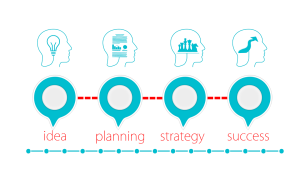A company’s corporate culture defines its personality and the way things are done in the day-to-day running of the business.
Corporate culture is shaped by the founder’s personality, the early employees, and how the company grows. While many companies try to define and shape their culture, it’s not always easy.
In addition, many companies believe that their culture is unique and can’t be changed, which results in negative outcomes when new people come into the company.
The reality is that most corporate cultures share some common characteristics, and implementing, as well as improving, your company’s culture typically follows a few basic steps.
In this article, the various types of corporate cultures will be defined, and the steps necessary to improve your company’s culture will be outlined. If you want to make sure your company has a culture that will help it succeed, keep reading.
What Is Corporate Culture? Definition & Meaning
Corporate culture is the system of shared beliefs and values that govern how a company is run. In other words, it’s the intangible things that make your organization unique.
Corporate culture can include things like the company’s mission statement, its core values, the way it communicates with employees, and the way it deals with customers.
While it’s not always easy to define corporate culture, there are usually some key elements that are common to most organizations.
For example, a strong corporate culture will typically be based on a clear set of values and principles that employees can easily understand.
It will also be focused on creating positive relationships with customers and other stakeholders.
And finally, it will encourage employees to take ownership of their work and be proud of the company they work for.
Why Is Corporate Culture Critically Important & The Benefits If Established
It is important to establish a healthy and good corporate culture because it is one of the key factors that determine the success or failure of a company.
Moreover, the right company culture can have several benefits for your organization.
10 Benefits of Corporate Culture
- A strong corporate culture can help a company attract and retain top talent
- A positive corporate culture can encourage employees to take ownership of their work and be proud of the company they work for
- A good corporate culture can improve employee morale and motivation
- A positive company culture can help reduce employee turnover rates
- Corporate culture can play a role in shaping customer perceptions of a company
- A good corporate culture can help create a competitive advantage for a company
- Corporate culture can help improve communication within an organization
- Corporate culture can help build teamwork and collaboration among employees
- A strong corporate culture can foster innovation and creativity among employees
- A positive company culture can improve company performance and profitability
4 Types of Corporate Culture (With Advantages & Disadvantages)
There are various types of corporate culture and each has its own set of advantages and disadvantages.
Let’s take a look at four of the most common types of corporate cultures.
1. Collaborative Culture
This type of culture is based on a sense of family and community. Employees are expected to work together harmoniously in teams to achieve common goals.
In this type of culture, employees are typically highly engaged and committed to the organization.
They feel a sense of ownership and responsibility for their work, and they are motivated by the desire to contribute to the success of the company.
The advantages of this type of culture include:
- Employees feel a sense of loyalty and commitment to the company
- There is a high level of trust and communication among employees
- Employees are willing to make sacrifices for the good of the company
The disadvantages of this type of culture include:
- There can be a lack of creativity and innovation due to a reluctance to take risks
- Employees may be resistant to change
- Conflicts can be difficult to resolve
2. Adhocracy Culture
Next, we have the adhocracy culture, which is based on the idea of “rule by the best.”
This type of culture is characterized by a focus on creativity and innovation, and employees are encouraged to come up with new ideas and take risks.
The advantages of this type of culture include:
- There is a high level of creativity and innovation
- Employees are rewarded for taking risks
- Employees are flexible and adaptable
The disadvantages of this type of culture include:
- There can be a lack of structure and chaos can reign
- Employees may be resistant to change
- Conflicts can be difficult to resolve
3. Market Culture
Market culture is based on the idea of “survival of the fittest.”
This type of culture is focused on competition and results. Employees are expected to be highly productive and meet aggressive performance goals.
The advantages of this type of culture include:
- There is a focus on results and productivity
- Employees are highly motivated to achieve results
- Employees are typically highly skilled and knowledgeable
The disadvantages of this type of culture include:
- There can be a focus on individual achievement at the expense of teamwork
- Employees may be overly aggressive and competitive
- Employees may be unethical in achieving results
4. Hierarchical Culture
Lastly, we have the hierarchical culture, which is based on the idea of “top-down.”
This type of culture is characterized by a strict hierarchy and a focus on obedience and compliance. Employees are expected to follow orders and not question authority.
The advantages of this type of culture include:
- There is a clear chain of command and everyone knows their place
- Employees are highly disciplined and obedient
The disadvantages of this type of culture include:
- There can be a lack of creativity and innovation
- Employees may be resistant to change
- Conflicts can be difficult to resolve
Signs Of a Great Organization Culture
Many signs indicate a company has a healthy, positive culture.
By following these key roles of great company culture, you can create an environment where employees are engaged and productive.
Let’s have a look at these key signs and roles.
Hiring the right people
When you hire the right people, it sets the tone for the rest of the company.
You need to make sure that you are hiring people who share your company values and who will be a good fit for the culture.
It’s also important to make sure that new employees are socialized into the culture quickly.
This means giving them opportunities to meet other employees, learn about the company values, and understand how they can contribute to the team.
In addition, the right people will help to reinforce the culture and make it stronger.
Having a cultural ambassador
A cultural ambassador is someone responsible for promoting and reinforcing the company culture.
They are typically highly respected by employees and play a key role in shaping the culture.
Cultural ambassadors can do such things as:
- Encouraging employees to be creative and innovative
- Promoting teamwork and collaboration
- Providing training on company values
- Fostering a sense of community among employees
- Leading change initiatives
Rewarding success
One of the best ways to promote a positive company culture is to reward success. When employees are rewarded for their hard work, it encourages them to continue doing their best.
Some of the most common ways to reward employees include:
- Cash bonuses
- Gift cards or vouchers
- Paid time off
- Company merchandise or logoed clothing
- Special privileges or access, such as being able to work from home occasionally
- Discounts on company products or services
Trusting staff
Trust is a key component of positive company culture. When employees feel that they are trusted by their managers, it builds a sense of mutual respect and cooperation.
This can lead to a more productive and engaged workforce.
Managers can build trust by being open and honest with staff, providing clear direction, and giving employees the freedom to make decisions.
Managers should also forgive mistakes, provided that employees are willing to learn from them.
Setting goals
Goals provide a sense of direction and purpose for employees. When employees have clear goals to work towards, it can help them to be more focused and motivated.
The best goal-setting practices involve:
- Setting realistic and achievable goals
- Make sure all employees are involved in setting goals
- Giving employees regular updates on their progress
- Providing feedback on how they can improve
Positive feedback
Employees love positive feedback. It’s a great way to show that you appreciate their efforts and it helps to motivate them to do even better.
Giving positive feedback leads to a positive corporate culture that employees enjoy being a part of.
Learning to give and receive feedback is an essential skill for any manager. Managers should make sure to give both positive and negative feedback constructively.
Creating a positive corporate culture can be a challenge, but it’s well worth the effort. By following these key signs and roles, you can create an environment where employees are engaged and productive.
Examples of Corporate Culture
There are a variety of different ways to define corporate culture, but in general, it can be described as the shared values and behaviors that exist within an organization.
It’s what makes each company unique and contributes to the overall feeling or atmosphere.
Big organizations that have been around for a while will have a culture that is quite different from a startup.
For example, McDonald’s has a very strong culture of speed and efficiency. This is reflected in the way they operate, from the way they make food to the way they serve customers.
On the other hand, Google is known for its innovative and creative culture. They encourage employees to be creative and come up with new ideas.
Amazon is another company with a very strong culture. They are known for their focus on the customer and their commitment to innovation.
So, how do you go about developing a corporate culture? There is no one-size-fits-all answer, but there are a few key things to keep in mind.
How To Develop a Great Corporate Culture
1. Determine the Company’s Core Values
One of the first things you need to do is determine your company’s core values. What are the fundamental principles that you want everyone in the organization to live by?
Some common core values include:
- Teamwork
- Respect
- Integrity
- Innovation
- Customer focus
Once you have determined your core values, make sure they are communicated to all employees and that everyone understands what they mean.
2. Establish Realistic Company Culture Goals
Once you have your core values in place, it’s important to set realistic cultural goals that align with those values.
What do you want your company culture to look like in the future? How can you get there?
It’s important to involve employees in setting these goals. They will be more likely to buy into them and work towards them if they have a say in the process.
Being realistic means that you may not be able to achieve your goals overnight. It will likely take time and effort, but it’s worth it in the long run.
Some common cultural goals include:
- Creating a positive and encouraging work environment
- Encouraging employees to be creative and innovative
- Developing a strong sense of teamwork
- Focusing on the customer
All of these goals should align with your company’s core values.
3. Get Employees Involved in the Process
Once you have your goals in place, it’s important to get employees involved in the process. This will help them to feel like they are a part of the organization and that their contributions are valued.
One way to do this is by having employees participate in setting goals. This can help to ensure that they are aligned with the company’s values and objectives.
Another way to get employees involved is by giving them regular updates on their progress. This helps them to see how they are contributing to the overall goal and makes them feel like they are a part of the process.
For a corporate culture to be successful, everyone in the organization must be on board. By following these key steps, you can create a culture that employees will be proud to be a part of.
Keep in mind that it will likely take time and effort to develop a great corporate culture, but it’s worth it in the long run.
By involving employees in the process, you can create an environment where they are engaged and productive.
10 Inspiring Quotes for Corporate Culture
Here’s a list of 10 quotes for a corporate culture that will motivate and inspire you:
- “Culture is to recruiting as product is to marketing.” – HubSpot’s Culture code
- “Culture is simply a shared way of doing something with a passion.” – Brian Chesky, Co-Founder, CEO, Airbnb
- “We try to have the kind of a culture that doesn’t value excuses in the sense that when you’re supposed to accomplish something, and you’re at a high level, then your job is to accomplish it, despite the difficulty. And you’re rewarded for dealing with that.” – Phil Libin, Co-Founder, former CEO of Evernote
- “We have a culture where we are incredibly self-critical, we don’t get comfortable with our success.” – Mark Parker, CEO, Nike
- “I look for two things when I hire a new employee: ambition and humility. Without a proven track record of initiative and ambition, it’s likely the person becomes a drain rather than a contributor to the company – even the really smart, talented ones.” – Justin McLeod, Founder, CEO, Hinge
- “Being a great place to work is the difference between being a good company and a great company.” – Brian Kristofek, President and CEO, Upshot
- “I think as a company, if you can get those two things right — having a clear direction on what you are trying to do and bringing in great people who can execute on the stuff — then you can do pretty well.”– Mark Zuckerberg, CEO, Facebook
- “Customers will never love a company until the employees love it first.” – Simon Sinek, author, Start with Why
- “We believe that it’s really important to come up with core values that you can commit to. And by commit, we mean that you’re willing to hire and fire based on them. If you’re willing to do that, then you’re well on your way to building a company culture that is in line with the brand you want to build.”– Tony Hsieh, CEO, Zappos
- “Hire great people and give them the freedom to be awesome.”– Andrew Mason, Founder, Groupon
FAQ About Corporate Culture
How Do You Establish a Strong Organizational Culture?
There are a few key things to keep in mind when creating or strengthening your corporate culture.
One of them is that all employees should be able to agree on the company’s core values, and these values should be reflected in everything the company does.
In addition, from the way new hires are recruited to the standards by which employees are evaluated, the culture should be evident in every aspect of the organization.
Another is that employees who feel engaged and invested in their work are more likely to buy into the company’s culture and contribute to its success.
Finally, employees who feel like they belong to a team or community are more likely to be loyal to their company and its culture.
What Is Corporate Culture Ethics?
There is no single definition of corporate culture ethics, but generally speaking, it refers to the ethical standards and values that are expected of employees within a company.
Corporate culture ethics can include things like respect for others, honesty and integrity, social responsibility, and environmental awareness.
Can Corporate Culture Be Changed?
Yes, it is possible to change corporate culture, but it’s not always easy. It typically requires a concerted effort from leadership to identify the areas that need improvement and make changes accordingly.
It’s also important to keep in mind that it can take time for a new culture to take hold, so be patient and don’t give up too soon.
How Will Corporate Culture Change In The Future?
It’s difficult to say exactly how corporate culture will change in the future, but we’ll likely see more companies emphasize social responsibility and environmental awareness.
The days of strictly focusing on profit and shareholder value may be coming to an end, as consumers are increasingly looking for brands that align with their values.
Additionally, we’re likely to see a rise in remote work and flexible work arrangements, as employees seek out more flexibility and autonomy in their careers. If we don’t like our choice, we can always consider using a professional career test to get more options to choose from.
Case Studies, Academic, and Research-Based Sources:
- Schein, E. H. (2010). “Organizational Culture and Leadership.” Jossey-Bass.
- Kotter, J. P., & Heskett, J. L. (1992). “Corporate Culture and Performance.” Free Press.
- Denison, D. R. (1990). “Corporate culture and organizational effectiveness.” Wiley.
- Cameron, K. S., & Quinn, R. E. (2011). “Diagnosing and Changing Organizational Culture: Based on the Competing Values Framework.” Jossey-Bass.
- Hofstede, G., Hofstede, G. J., & Minkov, M. (2010). “Cultures and Organizations: Software of the Mind.” McGraw-Hill.
- O’Reilly, C. A., Chatman, J., & Caldwell, D. F. (1991). “People and organizational culture: A profile comparison approach to assessing person-organization fit.” Academy of Management Journal.
- Burt, R. S. (2004). “Structural holes and good ideas.” American Journal of Sociology. This research links organizational structure to the generation of good ideas, relevant to innovative corporate cultures.
- Case Study: Google’s Organizational Culture. Harvard Business Review.
- Case Study: Zappos’ Company Culture. Stanford Graduate School of Business.







